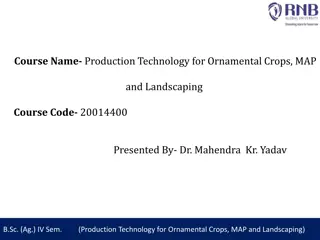Volatile Oils in Pharmacognosy and Phytochemistry: Composition, Chemistry, Uses
Volatile oils, also known as essential oils, are derived from terpenes and their oxygenated compounds. These oils possess characteristic odors and are extracted from plants through various methods like hydro-distillation and steam distillation. They are commonly used as flavoring agents, perfumes, a
0 views • 29 slides
Synthesis of Salicylic Acid: Theory, Derivatives, and Applications
Salicylic acid is synthesized from methyl salicylate through ester hydrolysis with aqueous alkali. It is a versatile compound used in organic synthesis, as a plant hormone, and derived from salicin metabolism. The derivatives of salicylic acid can minimize gastric disturbances and enhance therapeuti
4 views • 12 slides
Overview of Salicylic Acid and its Derivatives
Salicylic acid is known for its antiseptic, germicidal, and analgesic properties, used in various applications such as preservatives, wart treatments, and pain relief. Different derivatives of salicylic acid are developed to minimize side effects and enhance efficacy. Acetyl salicylic acid (ASA), co
0 views • 15 slides
Exploring Ethnobotanical Medicinal Practices in Different Cultures
Traditional medical practices in various societies utilize plants, herbs, and fruits for their healing properties. Common examples include garlic and ginger, known for their antiseptic and remedial qualities. This teaching exercise from Yale University delves into the diverse cultural perspectives o
3 views • 14 slides
Get Rid of Bacteria and Viruses with Effective F10 Germicidal Barrier Ointment
F10 Germicidal Barrier Ointment by Chemical Essentials is a game-changer in the battle against bacteria, fungi, and viruses. This antiseptic preparation is specially formulated to tackle open and contaminated wounds while preventing re-infestation.\n
1 views • 5 slides
Management of Quittor in Equine Medicine
Quittor is a condition in horses characterized by necrosis of lateral cartilage, leading to sinus openings in the coronet region. It can result from infections, pastern region necrosis, or suppuration from neighboring lesions. Symptoms include swollen coronet with sinus openings, potentially leading
0 views • 26 slides
Exploring the Wonders of Cinnamon Bark and Its Uses
Cinnamon bark, derived from Cinnamomum zeylanicum trees, is a revered spice known for its aromatic qualities. The powder showcases light brown or yellowish-brown color with a sweet taste. Microscopically, it contains phloem fibers, sclereids, and parenchyma fragments. This versatile ingredient serve
2 views • 8 slides
Comprehensive Guide to Hand Hygiene in Infection Control
Hand hygiene is crucial in infection control, encompassing various methods like routine hand washing, antiseptic hand wash, and surgical hand antisepsis. Different types of hand hygiene include routine, antiseptic, and surgical antisepsis for removing or destroying bacterial infection. Indications f
0 views • 7 slides
Surgical Skin Preparation: Importance and Best Practices
Surgical skin preparation is crucial to reduce microbes and prevent surgical site infections. It involves thorough cleansing to eliminate dirt, oils, and microbes while minimizing the risk of infection. Methods include mechanical friction and using antiseptic solutions like alcohol, iodine, and chlo
0 views • 34 slides
Ignaz Semmelweis and the Fight Against Puerperal Fever
Ignaz Semmelweis, a pioneer in antiseptic procedures, determined the cause of puerperal fever in the 19th century. His work led to a significant reduction in maternal mortality by identifying the importance of handwashing in healthcare settings. Puerperal fever, a common cause of death in women afte
0 views • 29 slides
Production Technology of Costus: Medicinal Herb Cultivation and Uses
Explore the production technology of Saussurea costus, a medicinal herb valued for its tonic, stimulant, and antiseptic properties in Ayurvedic medicine. Discover its uses in traditional Chinese medicine, aphrodisiac qualities, and benefits for various health conditions. Learn about cultivating Cost
0 views • 10 slides
Evolution of Wound Care: From Antiseptic Dressings to Acceleration Techniques
Explore the historical perspective, goals, factors affecting wound healing, nutrition's role, and strategies for accelerating wound healing. Learn about the mechanisms of wound injuries and the importance of a clean environment in wound care management.
0 views • 58 slides
Herbal Extracts in Cosmetics: Benefits and Applications
Explore the use of herbal extracts like Horse Chestnut, Licorice, and Linden in cosmetic products for skincare. Learn about their anti-inflammatory, antiseptic, and hydrating properties, making them ideal for treating various skin conditions and enhancing skin health.
0 views • 16 slides
Understanding Sterilization, Asepsis, and Antisepsis in Ancient and Modern Perspectives
Sterilization is the process of eliminating all microorganisms from an object or surface. Disinfection targets pathogenic microbes without spores. A good antiseptic/disinfectant should be chemically stable, affordable, non-staining, cidal, active against various pathogens, and able to spread effecti
0 views • 19 slides
Importance of Hand Hygiene in Nursing Practice: A Comprehensive Overview
In this lecture from the Fundamentals of Nursing Department at the University of Basrah College of Nursing, the critical role of hand hygiene in preventing infections in healthcare settings is emphasized. Various techniques such as hand washing, antiseptic hand wash, antiseptic hand rub, and surgica
0 views • 22 slides
Essential Concepts in Sterilization and Disinfection Practices
Understanding the principles of sterilization and disinfection is crucial in medical settings. This lecture covers topics such as defining sterilization, disinfectants, and antiseptics, different methods of sterilization (physical and chemical), the significance of heat sterilization, dry and moist
0 views • 19 slides















